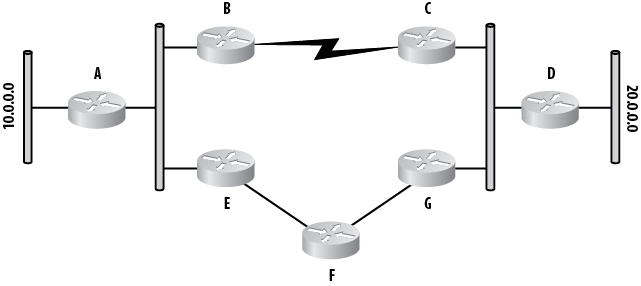Metrics and Protocol Types
The job of a routing protocol is to determine the best path to a destination network. The best route is chosen based on a protocol-specific set of rules. RIP uses the number of hops (routers) between networks, whereas OSPF calculates the cost of a route based on the bandwidth of all the links in the network. EIGRP uses links’ reported bandwidths and delays to determine the best path, by default, and you can configure it to use a few more factors as well. Each of these protocols determines a value for each route. This value is usually called a metric. Routes with lower metrics are more desirable.
Perhaps the simplest form of metric to understand is the one used by RIP: hop count. In RIP, the hop count is simply the number of routers between the router determining the path and the network to be reached.
Let’s consider an example. In Figure 10-4, there are two networks, labeled 10.0.0.0 and 20.0.0.0. Router A considers 20.0.0.0 to be available via two paths: one through Router B and one through Router E. The path from Router A through Router B traverses Routers B, C, and D, resulting in a hop count of three for this path. The path from Router A through Router E traverses routers E, F, G, and D, resulting in a hop count of four for this path.

Figure 10-4. Example of metrics in routing protocols
Lower metrics always win, so Router A will consider the path through ...